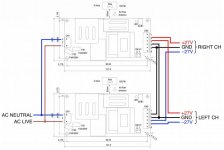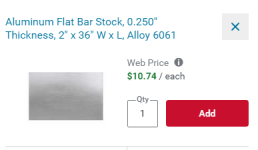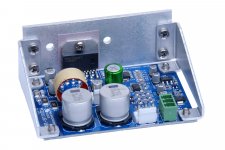i dont think enough emphasis has been made about this amps performance with less than Stella power supply's.
i see plenty of folks using hi quality toroidal supply's and the more quality offerings from connex and meanwell for smps but not a lot has been said about the much cheaper alternatives after all we are all diy guys and and like to save buck or two.
so far i have tested my mod 86 with nearly every power supply i have iv plumed the depths as far as quality with some very eye opening results.
1. Epson printer smps 24v 2A
2 KODAK PRINTER SMPS 24V 1.8A
3 ALBA TV SMPS POWER SUPPLY 24V 3A
4 SMSL CHEAP CHINESE CLASS D AMP SMPS 32V
5 MEANWELL LRS 100 36V SMPS RUN AT 33V £13
6 MEANWELL RPS 75 36V RUN AT 33V 2.1A £17
despite the obvious power and current limitations of some of these supply's (at least for what i needed) the mod86 performance with any of these supply was fantastic even the crap printer and tv smps sounded great.
being the golden eared audio snob i like to think i am i was sure i would be able to wax lyrical about the superiority of the RPS to the LRS and so down the line but if any thing the power supply rejection of this amp is so good im damned if i can hear any difference.
i see plenty of folks using hi quality toroidal supply's and the more quality offerings from connex and meanwell for smps but not a lot has been said about the much cheaper alternatives after all we are all diy guys and and like to save buck or two.
so far i have tested my mod 86 with nearly every power supply i have iv plumed the depths as far as quality with some very eye opening results.
1. Epson printer smps 24v 2A
2 KODAK PRINTER SMPS 24V 1.8A
3 ALBA TV SMPS POWER SUPPLY 24V 3A
4 SMSL CHEAP CHINESE CLASS D AMP SMPS 32V
5 MEANWELL LRS 100 36V SMPS RUN AT 33V £13
6 MEANWELL RPS 75 36V RUN AT 33V 2.1A £17
despite the obvious power and current limitations of some of these supply's (at least for what i needed) the mod86 performance with any of these supply was fantastic even the crap printer and tv smps sounded great.
being the golden eared audio snob i like to think i am i was sure i would be able to wax lyrical about the superiority of the RPS to the LRS and so down the line but if any thing the power supply rejection of this amp is so good im damned if i can hear any difference.
Last edited:
You need to create ±27-30 V for the Modulus-86. The Mean Well supplies provide +27 V, so two are needed to create ±27 V (plus-minus twenty-seven volt).
The Connex SMPS300RE provides ±30 V, so it can plug directly into the Modulus-86. One SMPS300RE (±30 V) is enough for a stereo Modulus-86 amp. If you'd rather build a dual-mono amp, you can use one SMPS300RE per channel of Modulus-86.
Tom
The Connex SMPS300RE provides ±30 V, so it can plug directly into the Modulus-86. One SMPS300RE (±30 V) is enough for a stereo Modulus-86 amp. If you'd rather build a dual-mono amp, you can use one SMPS300RE per channel of Modulus-86.
Tom
Connex has improved in last few years?
I bought 2 for a dual mono amp project.
Typical Audio Dilettante foolish attitude If one is good More must be better .. Right?
If one is good More must be better .. Right?
One Connex died within minutes and Ate the channels' output devices.
At least I assumed that was the reason.
Connex didn't even answer emails... ever.
I bought 2 for a dual mono amp project.
Typical Audio Dilettante foolish attitude
One Connex died within minutes and Ate the channels' output devices.
At least I assumed that was the reason.
Connex didn't even answer emails... ever.
i have had a few connex supply over the years and never had a any problems i also hear of a few hypex ncore guys who preferre the connex smps to hypex own smps its a shame you had such a bad experience as i believe they are a great supply
why not send unit back if it was faulty?
why not send unit back if it was faulty?
Connex has improved in last few years?
I bought 2 for a dual mono amp project.
Typical Audio Dilettante foolish attitudeIf one is good More must be better .. Right?
One Connex died within minutes and Ate the channels' output devices.
At least I assumed that was the reason.
Connex didn't even answer emails... ever.
Thats usually normal...
I bought and used an SMPS300RE earlier this year for another project, which I scrapped, so I already had it laying around. I never had any problems with it when I had it up and running.
Even though I know one supply will power the stereo pair, my OCD wants the symmetry inside the chassis.
Even though I know one supply will power the stereo pair, my OCD wants the symmetry inside the chassis.
Connex has improved in last few years?
I think it's the same designs they've been selling for years. There's a design tweak every now and then (the SMPS300RE I bought in 2014 is slightly different from those I bought in 2018), but the difference is not earth shaking.
I have two concerns regarding the Connex supplies:
- In three orders with them, I have received one batch that had the cheap blue Chinese terminal blocks for the mains input. Those tend to shred and short when you turn the screws (and indeed they did for me), so I swapped them out.
- The supplies are not protected against overload. The SMPS300RE is rated for "300 W" at a crest factor of 10 dB. So in reality, it's a 100-120 W supply. Pull 200 W from it and its output diodes will fry in about 10-15 minutes. Ask me how I know...
I think the transformer in the newer SMPS300REs is protected with a thermal cutoff, but the output diodes are most certainly not. At least the supply fails gracefully - its output voltage just goes to 0 V.
That said, if you're willing to swap a few terminal blocks and add temperature monitoring of the output diodes (or just add heat sinks), you could build something good around the Connex supplies.
I have never had a Connex supply fail in an audio amp that reproduced music (or a music-like signal like the 32-tone signal I use) even when operated at clipping levels for hours. I have had one fail during sine wave testing. Thankfully, most of us listen to music and not sine waves.
Connex didn't even answer emails... ever.
They respond within 24 hours (often faster than that) if you buy from them. Unfortunately, pre-sales support often seems to go by the wayside.
Christi was actually very fast to respond and very helpful when I fried my first SMPS300RE by overloading it. A few emails and two diodes later, I was up and running again.
Tom
Last edited:
I fooled around with the idea of an Adapter Plate. This was just 2" wide aluminum bar stock, 1/4" thick. It had mounting holes which match the diyAudio Store's Universal Mounting Specification (link), namely holes drilled in a rectangular pattern, 40mm x 80mm, same as UMS. I used a #29 drill bit for these holes to create some "play" in case my alignment was imperfect.
Now you mount the chipamp PCB to the Adapter Plate, and then mount the adapter plate to the heatsink. Using plenty of Thermal Grease of course.
Advantages: you never drill the heatsink, only the (inexpensive!!) adapter plate. So you get as many do-overs as you need without ever endangering the expensive heatsinks.
Disadvantages: (1) Now you're drilling seven holes and tapping three of them. That's more work than the conventional approach which drills and taps only 3 holes. (2) Extra cost of buying the aluminum bar stock. I bought 2" wide by 36" long from Grainger.com, which is enough to make seven adapter plates. It cost eleven dollars, image below.
_
Now you mount the chipamp PCB to the Adapter Plate, and then mount the adapter plate to the heatsink. Using plenty of Thermal Grease of course.
Advantages: you never drill the heatsink, only the (inexpensive!!) adapter plate. So you get as many do-overs as you need without ever endangering the expensive heatsinks.
Disadvantages: (1) Now you're drilling seven holes and tapping three of them. That's more work than the conventional approach which drills and taps only 3 holes. (2) Extra cost of buying the aluminum bar stock. I bought 2" wide by 36" long from Grainger.com, which is enough to make seven adapter plates. It cost eleven dollars, image below.
_
Attachments
I fooled around with the idea of an Adapter Plate. This was just 2" wide aluminum bar stock, 1/4" thick. It had mounting holes which match the diyAudio Store's Universal Mounting Specification
That ties you in with the DIY Audio Store as the vendor. Nothing wrong with that ... if you're in North America. Elsewhere, you're more likely to order directly from ModuShop, so you won't get UMS.
I know a couple people have build these amplifiers into a Dissipante 3U chassis, I'm assuming that I can't use the holes in the driver plate, does anybody have any mounting/case advice to share for using this chassis?
I'm usually able to find a position on the inner mounting plate where all the mounting holes of the board overlap with metal in the plate. Drill holes there. Then drill and tap the heat sink for the LM3886.
An alternative is to get the chassis without the inner plate and just drill into the bottom panel. That's pretty easy to do. Then drill and tap the heat sink for the LM3886.
Yet another alternative is to make an L-bracket out of 1.6 mm aluminum (0.064"). You'll want the short side of the L pointing down along the heat sink and mount the PCB to the long side of the L for support. Then drill and tap the heat sink for the LM3886 (or line up the LM3886 with one of the UMS holes and design the L bracket such that you can use some of the other UMS holes to hold it).
The key is that you want to support the circuit board at all four mounting holes and you want the LM3886 thermally connected to the heat sink.
I've used all three options above. I usually wait until the very end to solder the LM3886. This makes sure it lines up with its mounting hole. I also have a few rounds of dry-fits to make sure everything fits.
Tom
I use this in all my amps. Main advantage is that the tap holes can be actually pretty wide , 6/32 or 8/32 (or even wider ) since they are not used to mount the components to the heat sink but to mount the heatspreader to the actual heatsink.I fooled around with the idea of an Adapter
_
im crap at using hand tap i drilled through heat sink making sure hole was in the middle of the heat sink teeth and used a nut and bolt making sure the nut locked into space between teeth although this was for a fischer strait profile teeth not wave profile
That's another way to do it. It'll work especially well with the MAX08 clips too.
Tom
- Home
- Amplifiers
- Chip Amps
- Modulus-86 build thread


